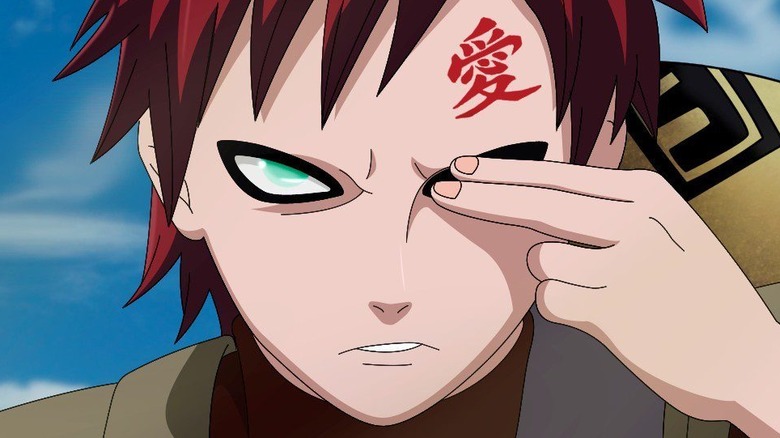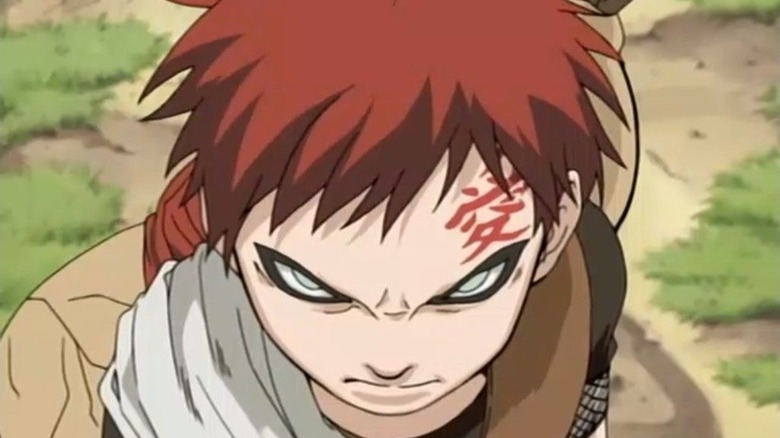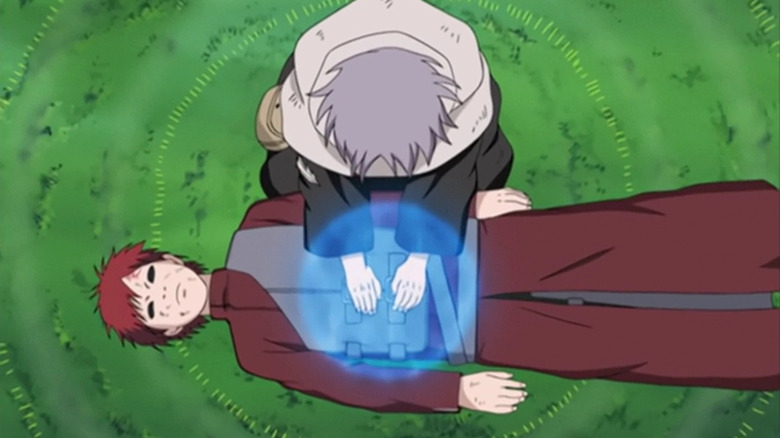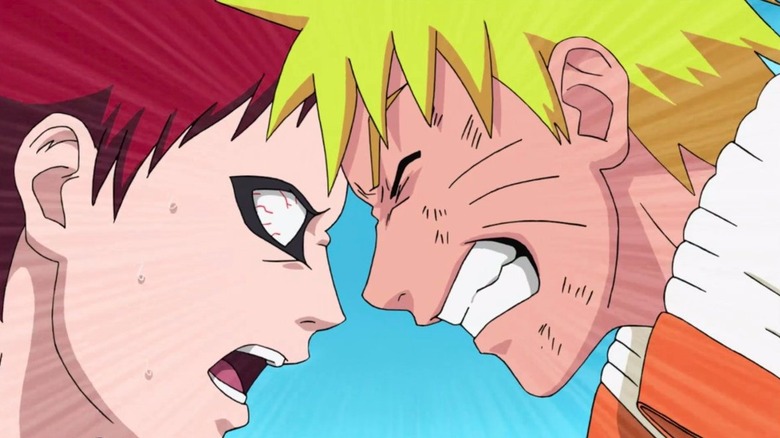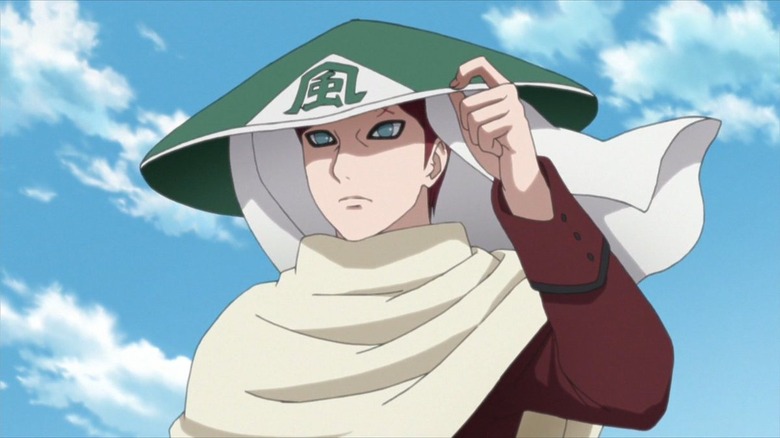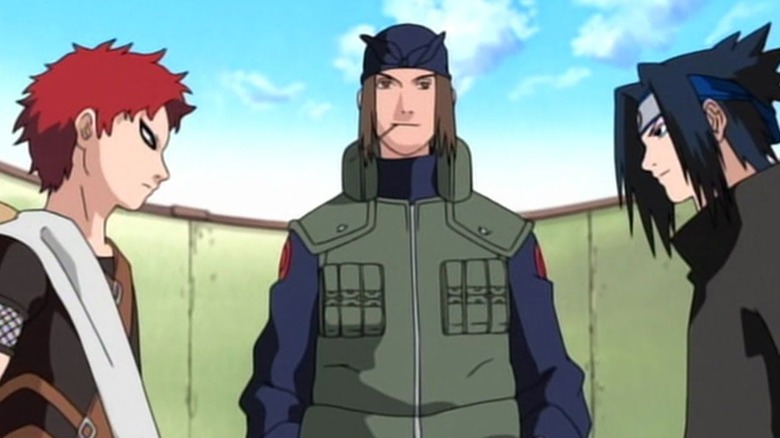The Untold Truth Of Naruto's Gaara
When Gaara of the Desert first appeared in "Naruto," it felt like a frightening rival gunslinger walking into town in a Western. There's an air of menace about him, and that's hardly surprising — nobody's been able to even make him bleed, never mind legitimately hurt him. Gaara starts out as a bloodthirsty monster for whom life has zero value, but he undergoes a transformation that's at the very core of "Naruto." He becomes one of the most compassionate, level-headed characters in the whole series.
The super-strong redhead wins the confidence of his village and becomes the Kazekage. At the Five Kage Summit in the sequel series "Naruto: Shippuden," Gaara is notably younger than all the rest, yet he has their respect. And, like everybody who meets the mischievous titular hero, Gaara soon counts Naruto among his best friends. In fact, it could be said that Naruto saved him from a life of anger and loneliness. Here's the untold truth of Gaara.
Gaara loved himself a little too much
Gaara's prominent face tattoo is the Japanese kanji for "Love," ironic given how cold he is at first. He soon reveals that he got that tattoo after he came to the conclusion that nobody else would ever love him, so he would have to love himself. While self-love is important, this was an unhealthy kind. It caused Gaara to believe that he was completely alone and that everybody else was dispensable. He even threatened to kill his own brother and, from the reaction, it was taken as a serious threat.
When Gaara meets Naruto, it's a humbling experience. The young Uzumaki reveals that his strength comes not from his love of himself, but from his love of his companions. This revelation begins a transformation in Gaara, setting him on the right path. The changes in him are apparent when he fights Kimimaro and comes to the rescue of the Leaf shinobi, specifically Rock Lee, who he had tried to kill when they last met.
The hidden meaning behind Gaara losing Shukaku
Gaara is the only jinchuriki who loses his tailed beast but is able to survive, thanks to Chiyo essentially giving him her own life. On the surface it means Gaara gets weaker. Yet the tailed beasts are much deeper analogies for the demons that can give people power but can also overwhelm them. Shukaku had made Gaara a feared outcast as a child. Whether he could have controlled Shukaku the way Naruto controls his tailed beast will never be known. What is known is that Shukaku, when allowed to come out during the Chunin Exams arc, turned Gaara into a fierce fighter.
The thing about Gaara is that he is still extremely powerful when he loses Shukaku. One could argue that the fact he commands the respect and love of his shinobi makes him stronger, even if his individual attack power isn't what it used to be. It also means that all of his power comes from within himself. In that sense, it is a perfect analogy for the strength we gain when we free ourselves from our painful demons. Deep down, "Naruto" is an allegory for the struggles we all go through in life, and Gaara is a prime example of that.
Gaara is the first enemy that Naruto turned into a friend
Gaara had been heading down a lonely, destructive path before Naruto showed him the power of friendship (albeit after headbutting him to wake him up). At the beginning of the series, Naruto himself was a lonely boy, acting out because it was the only way he could get attention. Like Gaara, many people shied away from him because of the demon inside him. Then, instructor Iruka Umino professed his compassion for Naruto, and the young shinobi went on to make many friends. Gaara, however, was the first person Naruto preached to about this transformation.
Naruto explained to Gaara that he had been reviled and hated, but by discovering friendship he finally became happy and truly powerful. This starts Gaara on his path to becoming one of the greatest shinobi in the land. He attributes this change to Naruto, and makes sure everybody knows not only that Naruto is his friend but also that he has made him into a better person. Naruto develops a habit of turning his enemies into friends, and Gaara is the one who got that ball rolling.
Gaara is the most level-headed Kage
When we meet the other village leaders during the Five Kage Summit, they all have great abilities and unique personalities. There is one common thread, though: They all have huge egos. That is, all except for Gaara. He stays calm as they all get fired up about the threat Sasuke represents, maintaining an unflappable exterior. It comes as a surprise given his former tendency to anger easily, and it's a sign of Gaara's complete transformation that he now acts as the voice of reason.
Of course, a central part of this is his love for and trust in Naruto. It is so strong that when Naruto returns to participate in the Fourth Great Ninja War, Gaara supports his friend while the rest of the Kage want to keep him in hiding. Even Tsunade hesitates longer than Gaara, who is able to look at the situation and admit that they need the help of one of the most powerful shinobi in existence, despite the risk.
Gaara and Sasuke are extremely alike
It's no coincidence that Gaara and Sasuke, the two strongest representatives of their respective villages during the Chunin Exams arc, seem to have a mutual respect upon meeting each other. They're both young and powerful shinobi at their first encounter. They also have no familial love at this point, and harbor a lot of anger. But, they eventually come to have one big thing in common: Naruto. Thanks to the love and respect shown to them by Naruto, they both find redemption and eventually take on brotherly roles to the orphan shinobi.
Gaara and Sasuke both owe a great deal to Naruto's unwillingness to give up on them. Naruto's own children eventually take to looking at each of them as uncles. Gaara and Sasuke in turn represent probably Naruto's closest friends and strongest allies. Arguably no shinobi have been more deeply impacted by the eventual 7th Hokage. By "Boruto," they are both full-fledged members of the family of Naruto with ties that run much deeper than blood.
